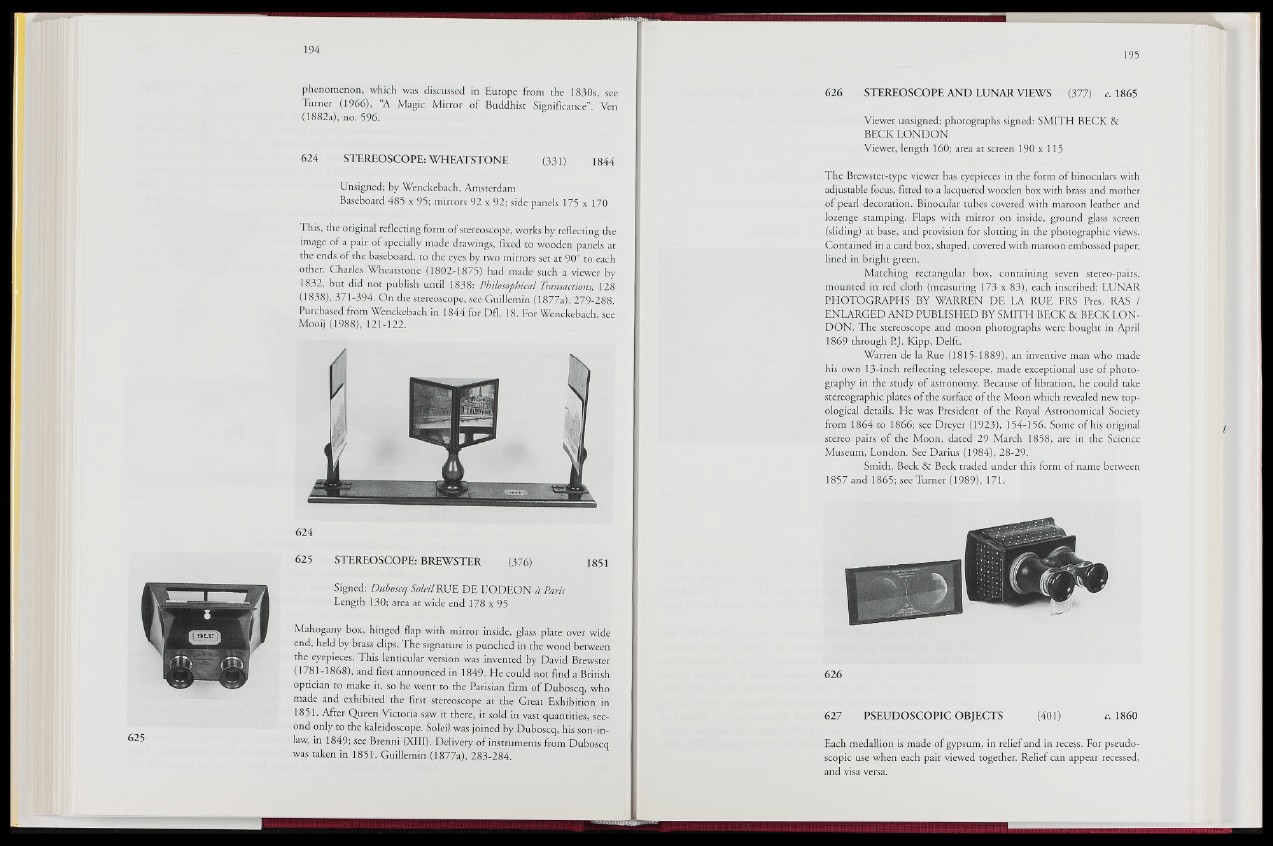
phenomenon, which was discussed in Europe from the 1830s, see
Turner (1966), “A Magic Mirror of Buddhist Significance”. Ven
(1882a), no. 596.
624 STEREOSCOPE: WHEATSTONE (331|. 1844
Unsigned; by Wenckebach, Amsterdam
Baseboard 485 x 95; mirrors 92 x 92; side panels 175 x 170
This, the original reflecting form of stereoscope, works by reflecting the
image of a pair of specially made drawings, fixed to wooden panels at
the ends of the baseboard, to the eyes by two mirrors set at 90° to each
other. Charles Wheatstone (1802-1875) had made such a viewer by
1832, but did not publish until 1838: Philosophical Transactions, 128
(1838), 371-394. On the stereoscope, see Guillemin (1877a), 279-288.
Purchased from Wenckebach in 1844 for Dfl. 18. For Wenckebach, see
Mooij (1988), 121-122.
625 STEREOSCOPE: BREWSTER (376) 1851
Signed: Duhoscq Soleil RUE DE L’ODEON a Paris
Length 130; area at wide end 178 x 95
Mahogany box, hinged flap with mirror inside, glass plate over wide
end, held by brass clips. The signature is punched in the wood between
the eyepieces. This lenticular version was invented by David Brewster
(1781-1868), and first announced in 1849. He could not find a British
optician to make it, so he went to the Parisian firm of Duboscq, who
made and exhibited the first stereoscope at the Great Exhibition in
185L After Queen Victoria saw it there, it sold in vast quantities, second
only to the kaleidoscope. Soleil was joined by Duboscq, his son-in-
law, in 1849; see Brenni (XIII). Delivery of instruments from Duboscq
was taken in 1851. Guillemin (1877a), 283-284.
626 STEREOSCOPE AND LUNAR VIEWS (377) c. 1865
Viewer unsigned; photographs signed: SMITH BECK &
BECK LONDON
Viewer, length 160; area at screen 190 x 115
The Brewster-type viewer has eyepieces in the form of binoculars with
adjustable focus, fitted to a lacquered wooden box with brass and mother
of pearl decoration. Binocular tubes covered with maroon leather and
lozenge stamping. Flaps with mirror on inside, ground glass screen
(sliding) at base, and provision for slotting in the photographic views.
Contained in a card box, shaped, covered with maroon embossed paper,
lined in bright green.
Matching rectangular box, containing seven stereo-pairs,
mounted in red cloth (measuring 173 x 83), each inscribed: LUNAR
PHOTOGRAPHS BY WARREN DE LA RUE FRS Pres. RAS /
ENLARGED AND PUBLISHED BY SM ljpB ECK & BECK LONDON.
The stereoscope and moon photographs were bought in April
1869 through P.J. Kipp, Delft.
Warren de la Rue (1815-1889), an inventive man who made
his own 13-inch reflecting telescope, made exceptional use of photography
in the study of astronomy. Because of libration, he could take
stereographic plates of the surface of the Moon which revealed new topological
details. He was President of the Royal Astronomical Society
from 1864 to 1866; see Dreyer (1923)* 154-156. Some of his original
stereo pairs of the Moon, dated 29 March 1858, are in the Science
Museum, London. See Darius (1984), 28-29.
Smith, Beck & Beck traded under this form of name between
1857 and 1865; see Turner (1989), 171.
626
627 PSEUDOSCOPIC OBJECTS (401) c. 1860
Each medallion is made of gypsum, in relief and in recess. For pseudo-
scopic use when each pair viewed together. Relief can appear recessed,
and visa versa.